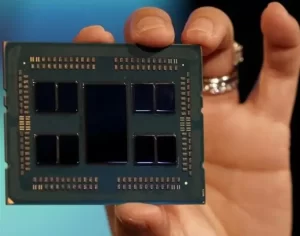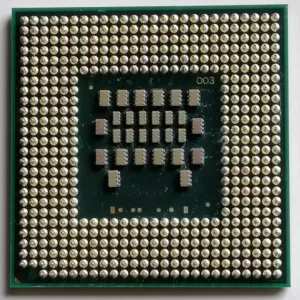A central processing unit (CPU) is the primary component of a computer that performs most of the processing inside the computer. It’s often referred to as the brain of the computer as it carries out the instructions of a computer program by performing basic arithmetical, logical, and input/output operations. The design and composition of a CPU are complex and involve numerous intricate components, each playing a pivotal role in the CPU’s functionality. Two such components are the CPU package and the CPU Core Chiplet Die (CCD). Although these terms may seem arcane to the uninitiated, they are integral to understanding a CPU’s structure and performance.
This article aims to shed light on these two fundamental concepts, elucidate their differences, and explore their roles in CPU performance and design. By the end of this article, you’ll have a clear understanding of what a CPU package is, what a CPU CCD signifies, and how they interact and contribute to the overall operation of a CPU.
What is CPU CCD?

The Core Chiplet Die (CCD) is a critical component within a CPU, particularly in the design of AMD’s Zen 2 and Zen 3 architectures. To understand what a CCD is, we first need to delve into the term “chiplet“.
The Chiplet Concept
In the realm of CPU design, a chiplet refers to a modular approach where different parts or ‘chiplets’ of a CPU are manufactured separately and then combined to form the complete processor. This methodology is opposed to the traditional monolithic design where all components are integrated onto a single chip. The chiplet-based design offers several benefits:
- Improved yields: Since individual components are produced separately, the overall failure rate reduces.
- Reduced manufacturing costs: Small components are easier and cheaper to manufacture.
- Flexibility: Ability to mix and match chiplets based on performance and power characteristics.
The Core Chiplet Die
In this context, a CCD refers to a ‘core chiplet die’, a chiplet that contains the CPU cores themselves. This is where the magic happens, where raw data is transformed into information.
AMD’s Zen 2 and Zen 3 Architectures
For instance, in AMD’s Zen 2 and Zen 3 architectures, a CCD comprises either 8 cores (Zen 2) or up to 16 cores (Zen 3). Each of these cores is capable of executing instructions independently of the others, allowing for efficient multitasking and parallel processing.
The Impact of CCD on CPU Performance
The number of CCDs and their integration into the CPU design can significantly impact the CPU’s performance. Here’s how:
- Multitasking: With more CCDs, a CPU can handle more tasks simultaneously, significantly improving multitasking.
- Computational Heavy Workloads: More cores mean more computations can be done in parallel, improving the performance for heavy workloads.
However, it’s important to note that the benefits of additional CCDs will depend on the software being used. Some applications may not be optimized to take full advantage of multiple cores or CCDs.
A CPU CCD is a crucial component that houses the CPU cores within a chiplet-based design. Its role and the number present within a CPU can substantially affect the performance, making it a critical consideration in CPU design and selection.
What is a CPU package?

When discussing CPU technology, we often overlook a fundamental aspect: the CPU package. This element is more than just a protective shell; it’s a critical part of a processor’s design and function.
The Basics of CPU Packages
In the simplest terms, a CPU package is the physical housing that encapsulates the processor die. The die refers to the silicon piece where the actual transistors – the working parts of a CPU – are located. The CPU package serves several essential purposes:
- Protection: It safeguards the delicate die from physical damage.
- Connectivity: The package provides the necessary electrical connections between the CPU die and the motherboard.
- Heat Dissipation: It aids in heat dissipation, often serving as a mounting point for heat sinks and fans.
You may also like: Can a CPU function independently from a motherboard?
The Importance of CPU Packages
The CPU package is a key determinant of a processor’s compatibility with a motherboard. Different CPUs require specific types of sockets on the motherboard, which are directly related to the CPU package.
Furthermore, the size and design of the CPU package can impact the overall thermal performance of a CPU. Certain packages are designed to disperse heat more effectively, allowing for better cooling and potentially higher performance.
Types of CPU Packages
There are several types of CPU packages, each with its unique characteristics and compatibilities. Here are a few examples:
- Pin Grid Array (PGA): In this type of package, pins are located on the underside of the CPU, fitting into matching holes on the motherboard socket. AMD’s AM4 socket CPUs use this type of package.
- Land Grid Array (LGA): Here, the pins are on the motherboard socket, and the CPU has corresponding contacts. Intel’s CPUs often use this type of package.
- Ball Grid Array (BGA): In this case, the CPU is permanently soldered to the motherboard, making it non-upgradable. This type of package is common in compact and mobile devices.
The CPU package is a critical component that not only protects the delicate CPU die but also ensures its proper functionality and compatibility with the motherboard. It’s a behind-the-scenes hero in the world of CPU technology.
You may also like: How Delicate Are CPU Pins?
CPU Package vs CPU CCD: What’s the Difference?
When examining CPU architecture, two terms that often come up are the CPU package and the CPU CCD. While both are integral parts of a CPU, they serve different roles and affect CPU design and performance in unique ways.
Comparing CPU Package and CPU CCD
The CPU package refers to the physical housing that encapsulates and protects the CPU die, providing electrical connections between the CPU and the motherboard. In contrast, the CPU CCD (Core Complex Die) refers to a part of the CPU die itself where the cores, or processing units, are located, especially in AMD’s Zen 2 and Zen 3 architectures.
Impact on CPU Design and Performance
The CPU package plays a crucial role in determining a CPU’s compatibility with different motherboards, as it’s designed to fit into specific types of sockets. It also impacts the CPU’s thermal performance, as the package design can aid in dispersing heat.
On the other hand, the CPU CCD significantly impacts CPU performance. In AMD’s Zen 2 and Zen 3 architectures, for instance, a CPU may contain multiple CCDs, each housing several CPU cores. The more cores a CPU has, the more tasks it can handle simultaneously, enhancing its performance, especially in multi-threaded applications.
While the CPU package and CPU CCD serve different roles in a CPU, they both significantly impact a CPU’s functionality, performance, and compatibility. Understanding these components’ nuances can provide valuable insight into how CPUs function and how to optimize their performance.
Frequently Asked Questions
What is the difference between CPU core and CPU package?
CPU cores are the processing units within the CPU that perform computations. A CPU may have multiple cores, which allow it to execute multiple tasks simultaneously, improving overall performance. The CPU package, on the other hand, is the physical container that holds the CPU die (including the cores), and it facilitates the connection between the CPU and the motherboard.
How do I choose the right type of CPU package?
Choosing the right CPU package depends on several factors including the type of motherboard you have, the type of CPU you’re using, and your cooling requirements. It’s crucial to ensure that the CPU package is compatible with your motherboard’s CPU socket.
Should I look at CPU package or CPU temp?
Both temperatures are important to monitor. The CPU core temperature is an indicator of the heat being generated by the processing units and can provide early warnings of overheating. The CPU package temperature, on the other hand, measures the overall temperature of the CPU, and high package temperatures can indicate potential issues with your CPU cooling solution. If either temperature is consistently high, it may be worth investigating and potentially improving your cooling setup.
